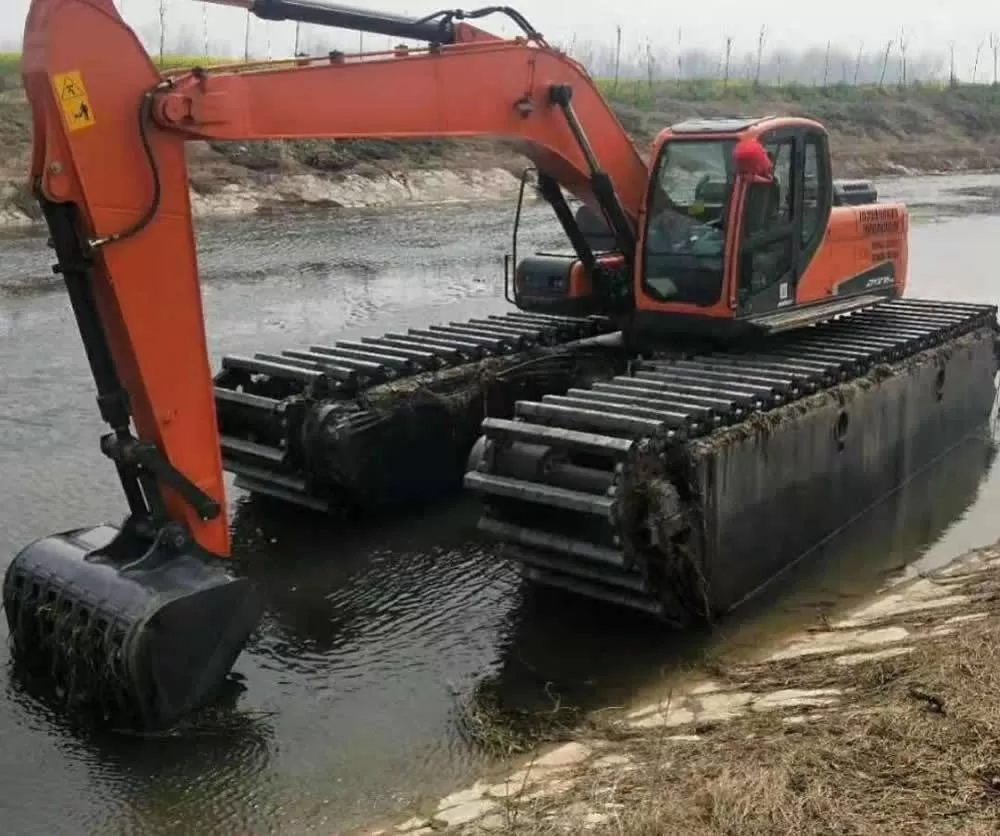
Amphibious excavators are specialized heavy machinery capable of operating efficiently on soft surfaces such as land, shallow water, and marshes. As a cross-border innovator in the construction machinery industry, amphibious excavators utilize a sealed pontoon structure, a waterproof engine compartment, and a corrosion-resistant hydraulic system. Their core principle lies in the use of sealed pontoons or a pontoon-type tracked chassis, creating a low ground pressure structure that offers both buoyancy and stability.
Dual-mode propulsion system: Rubber tracks are used on land to minimize ground damage, while pontoons provide over 800 kg/m³ of buoyancy in water.
Extra-long boom design: Standard 7-9 meter extended booms, combined with a 0.6 m³ shell bucket, enable deep-water operations.
Intelligent balancing control: Equipped with a tilt sensor and automatic counterweight system, the excavator maintains ±5° operating stability even in level 3 wave conditions.
Common designs also include adjustable track widths and modular pontoons to accommodate varying water depths and operating environments.
(1). High flexibility in both land and water transport: It can seamlessly switch between land and shallow water operations without the need for additional construction platforms or barges, significantly improving maneuverability.
(2). Cost and time savings: Instead of multiple devices, only one device can complete operations in both land and water environments, reducing equipment investment and construction preparation costs, and shortening the total project duration.
(3). Strong environmental friendliness: Due to the buoyancy design and low ground pressure, it can reduce environmental disturbances, have little impact on ecologically sensitive areas such as wetlands, and reduce restoration costs.
(4). Safety and stability: The buoyancy of the buoy and the optional spud anchor system can enhance operational stability; even if one of the chains breaks, the machine can still be moved to a maintenance point, reducing the impact of the failure.
(4). Convenient transportation and deployment: With a modular design, the buoy or platform can be disassembled and combined, making it easy to transport and deploy in remote or narrow environments.
Wetlands, swamps, and shallow areas: Suitable for dredging, channel maintenance, sediment removal, and other work.
Water conservancy projects: such as river channel regulation, dam construction and maintenance, and flood emergency rescue.
Environmental protection and ecological restoration: used for wetland restoration, alien plant removal, ecological reconstruction and other projects.
Port and waterway maintenance: suitable for port dredging, waterway maintenance, sedimentation dredging, etc.
Disaster rescue and emergency clearance: used for water area clearing, silt removal, and channel unblocking after flood disasters.
Operating cost comparison
|
project |
Conventional excavator + barge solution |
Amphibious models |
|
Shift Fee |
¥ 8500 |
¥ 6200 |
|
Auxiliary equipment costs |
30% |
0% |
|
Transition time |
4-6 hours |
≤1 hour |
(1). Convenient routine maintenance: High-quality manufacturers (such as Takeuchi and Komatsu) emphasize chassis and pontoon design for easy inspection and component replacement, making maintenance operations more efficient.
(2). Durable materials to reduce failure rates: High-strength, corrosion-resistant materials are used to manufacture pontoons, chains and key structures, which are durable and reduce frequent replacement costs.
(3) Sustainability of maintenance: The amphibious structure has the safety feature of being able to move even after the chain breaks, thus avoiding the downtime costs caused by accidents. (4) Operating cost structure: Although slightly higher than that of standard excavators, it can reduce the dependence on other equipment (such as barges and construction platforms) and save overall project costs. (5) Waterproof maintenance: Check the rotary seal ring every 50 hours, and the hydraulic valve group must be flushed with fresh water after wading operations. (6) Underwater sensor: Impedance detection is performed every quarter. Flexible leasing method: Suitable for short-term projects, which can avoid purchase costs. For long-term use, it is recommended to purchase to improve the return on investment.
The high initial purchase and maintenance costs of amphibious vehicles may limit their use in some projects with limited budgets. Amphibious excavators combine buoyancy with traditional excavator functions, making them an ideal choice for amphibious operations. It features:
Design Advantages: Floating track structure, low ground pressure, modular design;
Core Advantages: Flexible access, cost-effectiveness, safety, and environmental protection;
Applications: Wetland management, water conservancy projects, environmental restoration, and disaster response;
Maintenance Costs: While the purchase price is relatively high, it offers convenient maintenance, flexible rental options, and significant savings on overall project costs.
Against the backdrop of growing environmental awareness and the need for flood control, amphibious excavators are becoming a key force in future engineering projects.
If you have questions about amphibious excavators, or would like to customize one, please contact us. We offer custom excavator designs.